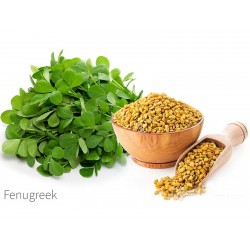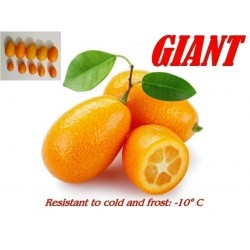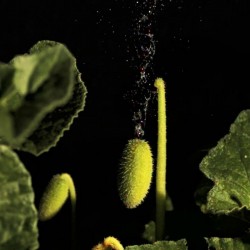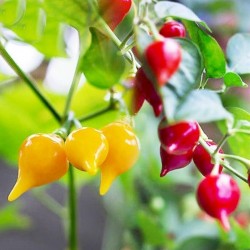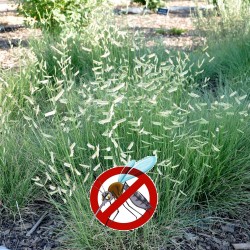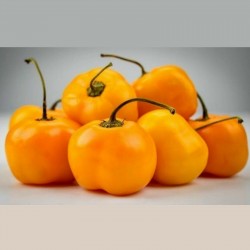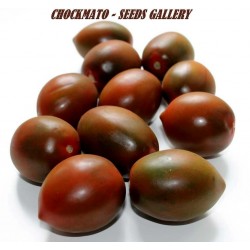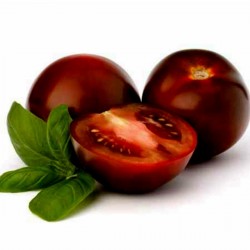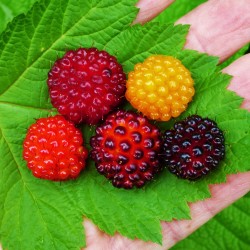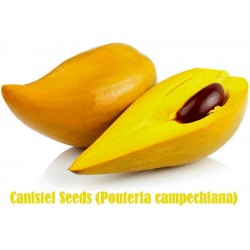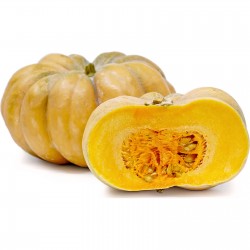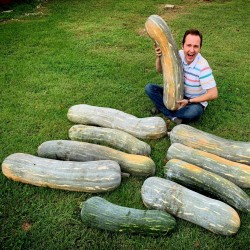Seeds Gallery Com,
5/
5
<h2><span style="text-decoration:underline;color:#000000;"><em><strong>Giant Kumquats or cumquats Seeds - exotic tropical fruit</strong></em></span></h2>
<h3><span style="color:#ff0000;"><strong>Price for Package of 3 seeds.</strong></span></h3>
<p><strong><span style="font-size:10pt;">This is a gigantic kumquat, which is more than three times bigger than ordinary kumquat.</span></strong></p>
<p><span style="font-size:10pt;">Kumquats or cumquats are a group of small fruit-bearing trees in the flowering plant family Rutaceae, either forming the genus Fortunella, or placed within Citrus sensu lato. The edible fruit closely resembles that of the orange (Citrus sinensis), but it is much smaller and ovular, being approximately the size and shape of an olive. The English name "kumquat" derives from the Cantonese pronunciation gam1 gwat1 (given in Jyutping romanization).</span></p>
<p><span style="font-size:10pt;">They are slow-growing evergreen shrubs or short trees, from 2.5 to 4.5 meters (8 to 15 ft) tall, with dense branches, sometimes bearing small thorns. The leaves are dark glossy green, and the flowers white, similar to other citrus flowers, borne singly or clustered in the leaf-axils. Depending on size, the kumquat tree can produce hundreds or even thousands of fruits each year.[1] The tree can be hydrophytic, with the fruit often found floating on water near shore during the ripe season.[citation needed]</span></p>
<div><span style="font-size:10pt;">The plant is native to south Asia and the Asia-Pacific region. The earliest historical reference to kumquats appears in literature of China in the 12th century. They have long been cultivated in Japan, Taiwan, the Philippines, and southeast Asia. They were introduced to Europe in 1846 by Robert Fortune, collector for the London Horticultural Society, and shortly thereafter into North America.</span></div>
<div><span style="font-size:10pt;">Classification</span></div>
<div><span style="font-size:10pt;">Carl Peter Thunberg originally classified the kumquats as Citrus japonica in his 1784 book Flora Japonica. In 1915, Walter T. Swingle reclassified them in a segregate genus, Fortunella, named in honor of Robert Fortune. Seven species of Fortunella have generally been recognized—F. japonica, F. margarita, F. crassifolia, F. hindsii, F. obovata and F. polyandra, as well as the recently described F. bawangica . The Flora of China returns the kumquat to Citrus and combines the species into the single species as Citrus japonica.[2]</span></div>
<div><span style="font-size:10pt;">Varieties :</span></div>
<div><span style="font-size:10pt;">Round kumquat</span></div>
<div><span style="font-size:10pt;">The round kumquat (also Marumi kumquat or Morgani kumquat) is an evergreen tree, producing edible golden-yellow colored fruit. The fruit is small and usually round but can be oval shaped. The peel has a sweet flavor but the fruit has a sour center. The fruit can be eaten cooked but is mainly used to make marmalade and jelly. It is grown as an ornamental plant and can be used in bonsai. This plant symbolizes good luck in China and other Asian countries, where it is sometimes given as a gift during the Lunar New Year. It's more commonly cultivated than most other kumquats as it is cold tolerant. It can be kept as a houseplant.</span></div>
<div><span style="font-size:10pt;">When the kumquats are divided into multiple species the name Fortunella japonica (Citrus japonica) is retained by this group.</span></div>
<div><span style="font-size:10pt;">Oval kumquat</span></div>
<div><span style="font-size:10pt;">Fortunella margarita, also known as the oval kumquat or the Nagami kumquat, is a close relative to Citrus species. It is a small evergreen tree, that can reach more than 12 ft (4 m) high and 9 ft (3 m) large. It is native to southeastern Asia, and more precisely to China. The oval kumquat has very fragrant citrus-like white flowers, and small edible oval orange fruits. The oval kumquat is an ornamental little tree, with showy foliage, flowers and fruits. It is also fairly frost-hardy, and will withstand negative temperatures such as 14 °F (-10 °C), and even a little lower for very brief periods. It can be grown in USDA hardiness zones 9 and warmer, but can also be tried in sheltered places, in USDA hardiness zone 8. Unlike most citrus species, the oval kumquat has a shorter growth period, and goes into dormancy fairly earlier in autumn. This partly explains its better frost hardiness.</span></div>
<div><span style="font-size:10pt;">Characteristics</span></div>
<div><span style="font-size:10pt;">The evergreen leaves of oval kumquats are deep-green and relatively small. They can reach up to 3 in (7 cm) long and 1.5 in (3.5 cm) wide. The white flowers of the oval kumquat are similar to the citrus flowers. They are strongly perfumed, and they appear relatively late in the growing season, generally late spring.</span></div>
<div><span style="font-size:10pt;">The oval kumquat is a fruit that looks like any citrus fruit, with an orange rind. The fruits are oblong, up to 2 in (5 cm) long. Unlike the common citrus, which have a rind which is inedible raw, oval kumquats have an edible sweet rind. The flesh, however, is not as sweet as the rind, and the juice is quite acidic and sour, with a lemon-like flavor. This fruit is generally eaten fresh, with its rind. It can also be processed into preserves, jams, and other products.</span></div>
<div><span style="font-size:10pt;">Cultivation</span></div>
<div><span style="font-size:10pt;">The oval kumquat needs a well-drained and fertile ground. It dislikes alkaline soils. The oval kumquat is susceptible to common citrus pests and diseases.</span></div>
<div><span style="font-size:10pt;">Jiangsu kumquat</span></div>
<div><span style="font-size:10pt;">The Jiangsu kumquat or Fukushu kumquat bears edible fruit that can be eaten raw. The fruit can be made into jelly and marmalade. The fruit can be round or bell shaped; it is bright orange when fully ripe. It may also be distinguished from other kumquats by its round leaves that make this species unique within the genus. It is grown for its edible fruit and as an ornamental plant. It cannot withstand frost.</span></div>
<div><span style="font-size:10pt;">When the kumquats are divided into multiple species the name Fortunella obovata (Citrus obovata) is used for this group.</span></div>
<div><span style="font-size:10pt;">Cultivation and uses</span></div>
<div><span style="font-size:10pt;">Kumquats are cultivated in China, South Korea, North Korea, Taiwan, Southeast Asia, Japan, the Middle East, Europe (notably Corfu, Greece), southern Pakistan, and the southern United States (notably Florida, Louisiana, Alabama) and California.</span></div>
<div><span style="font-size:10pt;">They are much hardier than other citrus plants such as oranges. The 'Nagami' kumquat requires a hot summer, ranging from 25 °C to 38 °C (77 °F to 100 °F), but can withstand frost down to about −10 °C (14 °F) without injury. They grow in the tea hills of Hunan, China, where the climate is too cold for other citrus fruits, even the Mikan (also known as the Satsuma) orange. The trees differ also from other citrus species in that they enter into a period of winter dormancy so profound that they will remain in it through several weeks of subsequent warm weather without putting out new shoots or blossoms. Despite their ability to survive low temperatures, kumquat trees grow better and produce larger and sweeter fruits in warmer regions.</span></div>
<div><span style="font-size:10pt;">Uses</span></div>
<div><span style="font-size:10pt;">Kumquats are often eaten raw. As the rind is sweet and the juicy center is sour, the raw fruit is usually consumed either whole—to savor the contrast—or only the rind is eaten. The fruit is considered ripe when it reaches a yellowish-orange stage and has just shed the last tint of green.</span></div>
<div><span style="font-size:10pt;">Culinary uses include candying and kumquat preserves, marmalade, and jelly. Kumquats can also be sliced and added to salads. In recent years kumquats have gained popularity as a garnish for cocktail beverages, including the martini as a replacement for the more familiar olive. A kumquat liqueur mixes the fruit with vodka or other clear spirit. Kumquats are also being used by chefs to create a niche for their desserts and are common in European countries.</span></div>
<div><span style="font-size:10pt;">The Cantonese often preserve kumquats in salt or sugar. A batch of the fruit is buried in dry salt inside a glass jar. Over time, all the juice from the fruit is diffused into the salt. The fruit in the jar becomes shrunken, wrinkled, and dark brown in color, and the salt combines with the juice to become a dark brown brine. A few salted kumquats with a few teaspoons of the brine/juice may be mixed with hot water to make a remedy for sore throats.[citation needed] A jar of such preserved kumquats can last several years and still keep its flavor.[citation needed]</span></div>
<div><span style="font-size:10pt;">In the Philippines and Taiwan, kumquats are a popular addition to green tea and black tea, either hot or iced.</span></div>
<div><span style="font-size:10pt;">In Vietnam, kumquat bonsai trees (round kumquat plant) are used as a decoration for the Tết (Lunar New Year) holiday. Kumquat fruits are also boiled or dried to make a candied snack called mứt quất.</span></div>
<div>
<div>
<div>
<table cellspacing="0" cellpadding="0" border="1"><tbody><tr><td colspan="2" width="100%" valign="top">
<p><span style="color:#008000;font-size:10pt;"><strong>Sowing Instructions</strong></span></p>
</td>
</tr><tr><td valign="top" nowrap="nowrap">
<p><span style="color:#008000;font-size:10pt;"><strong>Propagation:</strong></span></p>
</td>
<td valign="top">
<p><span style="color:#008000;font-size:10pt;">Seeds</span></p>
</td>
</tr><tr><td valign="top" nowrap="nowrap">
<p><span style="color:#008000;font-size:10pt;"><strong>Pretreat:</strong></span></p>
</td>
<td valign="top">
<p><span style="color:#008000;font-size:10pt;">0</span></p>
</td>
</tr><tr><td valign="top" nowrap="nowrap">
<p><span style="color:#008000;font-size:10pt;"><strong>Stratification:</strong></span></p>
</td>
<td valign="top">
<p><span style="color:#008000;font-size:10pt;">0</span></p>
</td>
</tr><tr><td valign="top" nowrap="nowrap">
<p><span style="color:#008000;font-size:10pt;"><strong>Sowing Time:</strong></span></p>
</td>
<td valign="top">
<p><span style="color:#008000;font-size:10pt;"> all year round </span></p>
</td>
</tr><tr><td valign="top" nowrap="nowrap">
<p><span style="color:#008000;font-size:10pt;"><strong>Sowing Depth:</strong></span></p>
</td>
<td valign="top">
<p><span style="color:#008000;font-size:10pt;">0.5-1 cm</span></p>
</td>
</tr><tr><td valign="top" nowrap="nowrap">
<p><span style="color:#008000;font-size:10pt;"><strong>Sowing Mix:</strong></span></p>
</td>
<td valign="top">
<p><span style="color:#008000;font-size:10pt;">Coir or sowing mix + sand or perlite</span></p>
</td>
</tr><tr><td valign="top" nowrap="nowrap">
<p><span style="color:#008000;font-size:10pt;"><strong>Germination temperature:</strong></span></p>
</td>
<td valign="top">
<p><span style="color:#008000;font-size:10pt;">min. 20° C.</span></p>
</td>
</tr><tr><td valign="top" nowrap="nowrap">
<p><span style="color:#008000;font-size:10pt;"><strong>Location:</strong></span></p>
</td>
<td valign="top">
<p><span style="color:#008000;font-size:10pt;">bright + keep constantly moist not wet</span></p>
</td>
</tr><tr><td valign="top" nowrap="nowrap">
<p><span style="color:#008000;font-size:10pt;"><strong>Germination Time:</strong></span></p>
</td>
<td valign="top">
<p><span style="color:#008000;font-size:10pt;">Until it Germinates 7days - 2 Months</span></p>
</td>
</tr><tr><td valign="top" nowrap="nowrap">
<p><span style="color:#008000;font-size:10pt;"><strong>Watering:</strong></span></p>
</td>
<td valign="top">
<p><span style="color:#008000;font-size:10pt;">Water regularly during the growing season</span></p>
</td>
</tr><tr><td valign="top" nowrap="nowrap">
<p><span style="color:#008000;font-size:10pt;"><strong> </strong></span></p>
</td>
<td valign="top">
<p><br /><span style="color:#008000;font-size:10pt;">Seeds Gallery 05.11.2012.</span></p>
</td>
</tr></tbody></table></div>
</div>
</div>
V 50 G
.png)
